I’ve gotten a lot of email about the previous tech articles, and since the majority of those emails ask for more, here we are! Today, I’m going to look at a few cards that have made a mark in some metagames, but may be a bit unappreciated in others—or have some new uses that you might not have thought of yet.
What cards are we examining today? You’ve probably seen them all before. Let’s take a look at Elemental Hero Wildheart, Dekoichi the Battlechanted Locomotive, Fissure (that old classic), Pole Position, Bottomless Trap Hole, and Twin-Headed Behemoth. That’s quite a list, so let’s get on with it!
Elemental Hero Wildheart
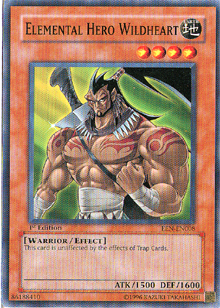 Elemental Heroes jumped into the spotlight due to their heavy use on Yu-Gi-Oh! GX, but they haven’t yet made a strong showing at a high-profile tournament. However, Elemental Hero Wildheart does have a fair degree of playability. It’s an interesting counterpart to cards like Pitch-Black Warwolf and Mirage Dragon in a trap-heavy environment.
Elemental Heroes jumped into the spotlight due to their heavy use on Yu-Gi-Oh! GX, but they haven’t yet made a strong showing at a high-profile tournament. However, Elemental Hero Wildheart does have a fair degree of playability. It’s an interesting counterpart to cards like Pitch-Black Warwolf and Mirage Dragon in a trap-heavy environment.
Now, both of these monsters do have 100 more ATK than Wildheart. That’s undeniable, but neither of those monsters are easy to search for. Check out Wildheart—it’s got the advantage of being a Warrior, an Earth monster, and a monster with 1500 ATK. That means you can search it out with Reinforcement of the Army, Giant Rat, Warrior Lady of the Wasteland, and Sangan. Four different ways to search? You can’t get much more accessible than that.
While Wildheart will dodge the popular traps that would otherwise destroy it, like Sakuretsu Armor, Widespread Ruin, Bottomless Trap Hole, Trap Hole, and Torrential Tribute, its usefulness doesn’t end there. I don’t know many duelists who don’t like recursion, and Call of the Haunted is in nearly every deck. Wildheart works marvelously with Call of the Haunted, since it will remain on the field if Call is destroyed or removed (there’s still a lot of Giant Trunades where I am). If you’re playing Return from the Different Dimension and want to keep some of those removed-from-play monsters, Wildheart is worth playing, as it will remain on the field after being special summoned.
1500 ATK might not seem like much, but it’s enough to take out many of the monsters that are increasing in popularity, like Don Zaloog, and it can also stand its ground against Mystic Tomato. Give it a try!
Dekoichi the Battlechanted Locomotive
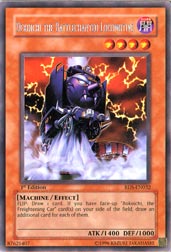 I’ve seen Dekoichi in lots of decks in the last few tournaments I’ve attended, so I know that it’s not a neglected card. However, there are plenty of players who might not realize how to use it to its full capabilities, so I’m including it in the list here. Dekoichi has three chief uses, and most decks that run it include it for one or more of these reasons.
I’ve seen Dekoichi in lots of decks in the last few tournaments I’ve attended, so I know that it’s not a neglected card. However, there are plenty of players who might not realize how to use it to its full capabilities, so I’m including it in the list here. Dekoichi has three chief uses, and most decks that run it include it for one or more of these reasons.
First, it works as a drawing engine. We’ve lost Pot of Greed and Graceful Charity, so what are we to do? Drawing more cards gives you the options that you need to win, after all, and that’s where Dekoichi can come in handy. Many players combine it with Tsukuyomi for a renewable source of drawing power every turn that they can keep it on the field. Flip it face down, flip it face up, get another card! What fun.
Second, it provides tempo control. If you’ve got an opponent who is constantly attacking and using cards like Smashing Ground and Sakuretsu Armor to try and keep you on the ropes with one-for-one card exchanges, pressing you into a topdecking situation, Dekoichi is his or her worst nightmare. It can rob your opponent of the ability to make battle-based card exchanges, slowing the tempo and ruining his or her plans. Every time your opponent attacks Dekoichi and you lose it to battle, you still draw a card. The aggressive opponent does clear a monster off the field, but he or she doesn’t gain card advantage, and that counters an onward rush to victory.
Third, once Dekoichi is destroyed, it helps fill the graveyard for Pot of Avarice without costing you a card, as long as the flip effect worked. It’s true that Magical Merchant fills up the graveyard faster, but its ATK value is far lower and it isn’t nearly as effective a draw engine when used with Tsukuyomi.
Why use a monster like Dekoichi for draw power instead of, say, Jar of Greed? Monster cards that give the same effects as a trap or spell can make more sense, in terms of card advantage. If you get the effect from a flip summon, you get the effect, and the monster remains on the field instead of heading to the graveyard. If it comes down to a topdecking situation, a monster will almost always be more valuable than a trap card, since it can protect your life points as well as provide you with a valuable effect. It’s also a Dark monster, which is attractive to Chaos players, and its 1400 ATK isn’t the handicap that it used to be.
Dekoichi is vulnerable to cards like Nobleman of Crossout and Mystic Swordsman LV2, but the general usefulness of the card makes for a fair trade. If you find that fast, aggressive, or Beatdown-type decks are making your life difficult, experiment with Dekoichi and see if it helps turn the game to your advantage.
Fissure
 I remember Fissure! Years and years ago, I had two or three of them in my deck and I never minded going second. Of course, that was before they had all these new-fangled flip effect monsters. No, back then Man-Eater Bug and Trap Master were good enough for us . . . but that’s enough nostalgia for now.
I remember Fissure! Years and years ago, I had two or three of them in my deck and I never minded going second. Of course, that was before they had all these new-fangled flip effect monsters. No, back then Man-Eater Bug and Trap Master were good enough for us . . . but that’s enough nostalgia for now.
Fissure is seeing a lot of play again. Admittedly, not in Shonen Jump Championship Top 8s, but in local tournaments. While it's usually a substitute for Smashing Ground for players who can’t get their hands on that high-demand card, it actually does have a few advantages.
It won’t get wasted on high-DEF monsters that you’re not terribly worried about, like Gravekeeper's Spy. Do you really want to waste a piece of removal on a card that your opponent summoned for free? It can also hit Spirit Reaper, due to Reaper’s low ATK, and that can be really important if your opponent’s got a Reaper and monster advantage. Stupid Reaper, sitting there, mocking you and saying, ”IIII’m a Spiiirit Reaper, IIIIIII can’t be destroyed in baaaa-aaattle!” Those things drive me crazy. Go, Fissure, go!
Anyway, if you want to try it out, remember that it can't take down big monsters if other monsters with lower ATK values are around. It often can't deal with big hitters like Cyber Dragon, or D. D. Assailant. You’ll also be unhappy if you activate it and your opponent responds by chaining Scapegoat. Still, Scapegoat is limited to one copy per deck now, and the resurging interest in tribute monsters often results in only one monster on the field. Fissure can work well in decks that are experimenting with weird tempo, acting as a fourth Smashing Ground. Don’t discount it just because it’s old and you like the new version better – take it for a test-drive and see how it works for you.
Pole Position
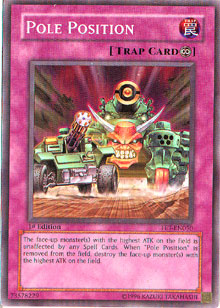 At the San Francisco Shonen Jump Championship, Robert Pace made excellent use of Pole Position. While he didn’t make the Top 8, he did succeed in showing off many of the card's strengths.
At the San Francisco Shonen Jump Championship, Robert Pace made excellent use of Pole Position. While he didn’t make the Top 8, he did succeed in showing off many of the card's strengths.
The most obvious use, of course, is to chain it as a response to being targeted by Mobius the Frost Monarch. If Mobius is the monster with the highest ATK on the field at the time (and it often is), Mobius is destroyed by Pole Position's second effect. That’s always fun! You can also do the same to Breaker the Magical Warrior if it’s the biggest monster on the field. And since Breaker is in the new Spellcaster’s Judgment Structure Deck, you know you’ll be seeing it often.
Pole Position can prevent Snatch Steal and Smashing Ground from destroying your Cyber Dragon or other large monster. You paid a lot for that Cyber Dragon, and you don’t want your opponent to blast it into oblivion, or worse yet, take it away from you and beat you over the head with it, do you? Of course you don’t. Pole Position can be used in a chain with the above cards for card advantage, and it can even be activated after Snatch Steal's resolution to take back your monster.
It combos well with Dark Hole if you’ve got the strongest monster, and helps open up the field for a clear shot at your opponent’s life points. It will also allow your biggest monster to ignore Level Limit – Area B or Messenger of Peace, both of which can be incredibly frustrating cards to go up against. As long as you control the biggest monster, it’s also protected from spells like Book of Moon, Brain Control and Soul Exchange. If your opponent brings out a bigger monster, you’ll be able to take it out with a well-played Mystical Space Typhoon.
Pole Position has a lot of tricky rulings to go along with it, though. If you’re going to use it, make sure to read those rulings carefully so you know what you’re doing. You won’t make your judges happy if you just pull this trap out and start slinging it all over the field without doing your homework first, so study up! You may find that Pole Position will give you a lot of advantage if you use it well.
Bottomless Trap Hole
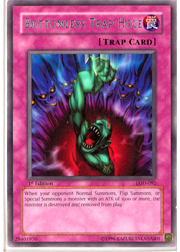 While Bottomless Trap Hole has always seen some level of play, its use as a tech card to halt Return from the Different Dimension has given players new interest in it. When Return from the Different Dimension is activated, a successfully activated Bottomless Trap Hole will inhale all the monsters with 1500 ATK or more (except Elemental Hero Wildheart, of course) that were special summoned, in one go. It's become a top pick for side decks lately, and six of the Top 8 players in San Francisco’s Shonen Jump Championship ran it in either their main or side decks. The event's champion, Fili Luna, included the card in both his main and side decks. As an interesting result, some players are now putting multiple copies of D. D. Survivor into their decks to avoid being completely stripped by Bottomless Trap Hole.
While Bottomless Trap Hole has always seen some level of play, its use as a tech card to halt Return from the Different Dimension has given players new interest in it. When Return from the Different Dimension is activated, a successfully activated Bottomless Trap Hole will inhale all the monsters with 1500 ATK or more (except Elemental Hero Wildheart, of course) that were special summoned, in one go. It's become a top pick for side decks lately, and six of the Top 8 players in San Francisco’s Shonen Jump Championship ran it in either their main or side decks. The event's champion, Fili Luna, included the card in both his main and side decks. As an interesting result, some players are now putting multiple copies of D. D. Survivor into their decks to avoid being completely stripped by Bottomless Trap Hole.
Twin-Headed Behemoth
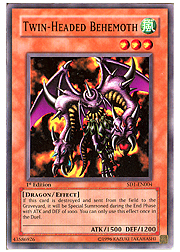 This is another card that had a run of popularity some time ago, then faded out. It hasn't really broken out into the limelight of Shonen Jump Championship success yet, which would move it along into the mainstream once again, although Hugo Adame did play it at the East Coast vs. West Coast showdown. Basically, it provides a nice +1 card advantage when it’s hit by Sakuretsu Armor, and it's a good choice for an opening monster set. Its 1500 ATK makes it searchable by Sangan, and it makes a great defensive topdeck in the late game.
This is another card that had a run of popularity some time ago, then faded out. It hasn't really broken out into the limelight of Shonen Jump Championship success yet, which would move it along into the mainstream once again, although Hugo Adame did play it at the East Coast vs. West Coast showdown. Basically, it provides a nice +1 card advantage when it’s hit by Sakuretsu Armor, and it's a good choice for an opening monster set. Its 1500 ATK makes it searchable by Sangan, and it makes a great defensive topdeck in the late game.
Twin-Headed Behemoth was popular at one time, so dig through your boxes and binders until you find your copy, and see how it works for you. Even with only 1000 ATK when it’s special summoned by its effect, it can still help you control the pace of the game and keep you in the duel long enough to make a comeback.
Is it just me, or are we seeing a lot of new approaches to deckbuilding in the latest round of Shonen Jump events? Different decks are in each Top 8, and as soon as one goes up, more decks spring to life to combat it. I can’t wait for each new Championship to see what people will think of next. I hope you’ve gained some insight and ideas from reading over today’s tech update, and I’m interested to hear about cards in your metagame that you think could make a real break in general Organized Play. Perhaps you’ll even see them featured in my next update. If you’ve got a card you think should be covered, email me and let me know!
You wouldn’t believe the state of my inbox when I got back from my last trip to Tokyo. Really, you wouldn’t. I’m so sorry for the delay in answering your emails, but if you aren’t worried about creating a black hole in Gmail, go ahead and give me a shout at MetagameJulia@gmail.com . . . unless you want to shout at me about not answering your previous email yet. If you do that, I swear, I’ll just cover my ears.